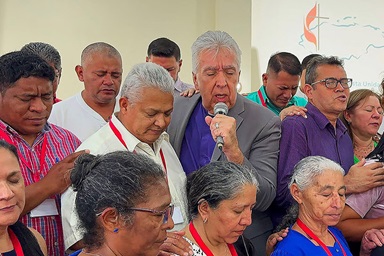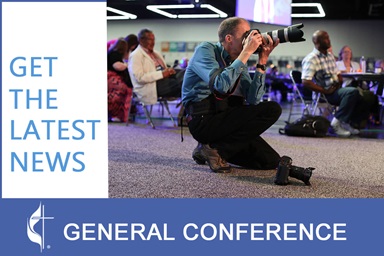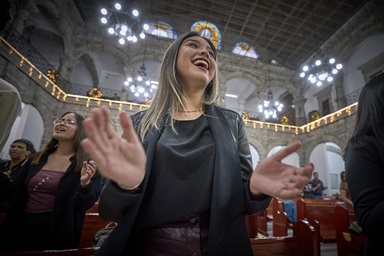The Rev. Francisco Cañas, a native of El Salvador, came to the United States more than three decades ago because of political conflicts in his country. Active in various ministries dedicated to serving the Hispanic-Latino communities and immigrant population in California, he helped initiate United Methodism’s National Plan for Hispanic-Latino Ministry. The initiatives that led to the Plan in 1992 date back to the early 1970s. Director of the Plan since 2006, Cañas is familiar with the history, realities, challenges and projections of this initiative. Gustavo Vasquez interviewed him for United Methodist Communications.The initiatives that led to the Plan in 1992 date back to the early 1970s.
Director of the Plan since 2006, Cañas is familiar with the history, realities, challenges and projections of this initiative. In an interview with United Methodist News Service, he shared his experiences.
What was the role of leaders in this process?
The Plan was an effort of the general agencies to coordinate existing resources and ministries to be more effective nationwide. Parallel to this effort was the consciousness that had been forming in the Hispanic community of The United Methodist Church – strengthening the connection between those in local churches throughout the country with those providing resources and new ideas for our work.
Several factors led to the development of the Plan. One was the explosive population growth of the Hispanic community during the ‘80s and early ‘90s. People immigrated for economic and political reasons.
In the ‘80s, I worked as a local pastor in Los Angeles. In seminary, I began to relate to the student life and church community and witness the struggles within the framework of the California-Pacific Annual Conference. It was necessary to reinvent the ministerial work with our community, and that was the birth of the Hispanic Mission, directed by the Rev. Leo Nieto. The growing interest in building a platform that would consolidate the various initiatives spread to other regions.
In the midst of this process, what was your incorporation into the movement of the Plan like?
In the early ‘90s, the focus was on developing training materials for lay missionaries and integrating a national team of facilitators. That team consisted of about 15 people representing the jurisdictions. I was called to this team with colleagues, such as Bishop Minerva Carcaño and the Rev. Edwin Cotto. We spread throughout the country to assist in workshops for lay leaders, based on what we still call “modules,” in an effort to train lay people as companions to pastors and parishes.
The cultural diversity of the Hispanic-Latino people is deep and growing. Within this segment of the population have always coexisted many cultures, languages, histories and idiosyncrasies.
How has the Plan addressed this growing diversity?
At first, it was called “National Hispanic Plan.” Later, “Latino” was added. The name change reflected inclusiveness because the commitment was with all Latin-American communities, including Portuguese-speaking Brazil.
Today, this commitment transcends continental boundaries. It goes all the way to Europe because of the large number of Hispanics (including Spaniards and Latin Americans) in that continent.
With the retirement of the Rev. José Palos, founding director of the Plan, other leaders held the position you now have. Upon your arrival, what was the status of the Plan and what fruits did you bear from the decade prior to your arrival?
I found an incredibly large team of lay missionaries at a national level, a new generation of Hispanic leaders. It was like raw ore that had to be worked, processed and molded to get the ministerial benefits.
One of the most important things the Plan did at the time was gain recognition for the rise of Hispanic-Latino leaders in decision-making levels of the church. The point of the Plan was always to provide resources and trainings for conference leaders, strengthen existing congregations, recruit candidates for pastoral work at different levels and coordinate the network of pastors in the various regional areas.
The fruits of the Plan have been many. Without a doubt, I can say that after 27 years of experience as a pastor and nine years as the director of the Plan, in the Hispanic-Latino communities, the Plan is one of the best bodies of ministerial development of all the mainline denominations.
A recent study by the Pew Research Center noted that the Hispanic-Latino population is the only group that has grown within all Christian traditions (Protestant and Catholic), even in historic churches (such as The United Methodist Church).
What are the challenges the Plan is facing in the response to the present-day demands?
The accelerated impact of technological change leaves us as a church significantly behind. All sociological changes taking place in terms of ethnic and racial diversity, the recognition of sexual diversity under new paradigms and multicultural convergence affect the church. These are challenges because we know that within the Hispanic community, there are taboos and resistance to the changes taking place in society and, inevitably, the church.
Challenges must be met with strategies to address them holistically. What are the strategies and lines of work in the Plan’s view of the future?
We remain focused on laity leadership development. We constantly work on renewing and contextualizing training materials to provide tools in response to the increasingly diverse reality and to incorporate youth and children in the church.
As part of the strategy of the Plan, a third national consultation last March brought together leading clerics and laity of all ages, jurisdictions, hierarchical levels, cultures and languages to explore the future of Hispanic-Latino ministry.
What was the importance and the results of the consultation?
The consultation made it clear that the institution and Hispanic-Latino leaders for years abandoned the youth and ignored their capabilities. Youth are able to adapt and respond to challenges with greater ease and efficiency than most adults.
In 15 years, we have seen many profound changes, and the church has not lifted a finger to contextualize our presence in time and place. As a Hispanic-Latino community, we have to update ourselves so that we can redefine our role and our place in this society and this church and reassess ourselves as God's people.
Vasquez is director of the Hispanic/Latino Communications, United Methodist Communications in Nashville, Tennessee.
News media contact: The Rev. Gustavo Vasquez, United Methodist Communications, [email protected], 615-742-5400.
Like what you're reading? Support the ministry of UM News! Your support ensures the latest denominational news, dynamic stories and informative articles will continue to connect our global community. Make a tax-deductible donation at ResourceUMC.org/GiveUMCom.




